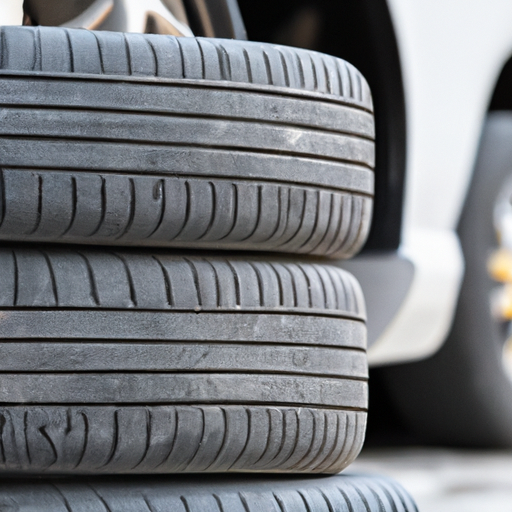Imagine never having to worry about getting a flat tire on the road ever again. Sounds too good to be true, right? Well, thanks to the incredible technology of run-flat tires, this dream is now a reality. These innovative tires are designed to keep you moving even when you experience a puncture, allowing you to safely reach your destination without the hassle of changing a tire on the side of the road. But how exactly do they work their magic? Let’s explore the fascinating world of run-flat tires and discover the science behind their incredible functionality.
What are run-flat tires?
Definition of run-flat tires
Run-flat tires are a type of tire designed to allow a vehicle to continue driving even after a significant loss of air pressure. Unlike traditional tires, run-flat tires are engineered to support the weight of a vehicle even with little to no air pressure. This unique design feature provides added safety and convenience in the event of a tire puncture or blowout.
Types of run-flat tires
There are two main types of run-flat tires: self-supporting and auxiliary supported.
-
Self-supporting run-flat tires: These tires have reinforced sidewalls that are capable of supporting the weight of the vehicle, even with little to no air pressure. The reinforced sidewalls allow the tire to maintain its shape and stability, providing a safe and comfortable ride.
-
Auxiliary supported run-flat tires: These tires rely on an additional support system, typically in the form of an inner ring or insert, to provide the necessary structure and support in the event of air loss. The inner support system prevents the tire from collapsing, allowing the vehicle to continue driving for a certain distance at reduced speeds.
Advantages of run-flat tires
Run-flat tires offer several advantages over traditional tires:
-
Safety: One of the key advantages of run-flat tires is the enhanced safety they provide. Even in the event of a tire puncture or blowout, run-flat tires allow you to maintain control of your vehicle and continue driving to a safe location. This eliminates the need to change the tire on the side of a busy road or in dangerous conditions.
-
Convenience: Run-flat tires eliminate the need for a spare tire, jack, and other tools typically used to change a flat tire. This not only saves space in the trunk of your vehicle but also eliminates the hassle and time-consuming process of changing a tire on the side of the road.
-
Cost savings: While run-flat tires may have a higher initial cost compared to traditional tires, they can help save money in the long run. With run-flat tires, you don’t need to invest in a spare tire, and you can avoid the costs associated with roadside assistance or getting towed to a repair shop.
How do run-flat tires work?
Internal structure of run-flat tires
The internal structure of run-flat tires is what allows them to support the weight of a vehicle even with little to no air pressure. These tires are built with reinforced sidewalls that are much stronger and stiffer than those of traditional tires. The sidewalls are made from specialized materials such as rubber and reinforced with layers of strong, durable materials like Kevlar or steel.
Support technologies for run-flat tires
To provide further support and stability, run-flat tires may also incorporate additional technologies. One such technology is the use of special beads or liners within the tire, known as self-sealing technology. These beads or liners contain sealing compounds that can help seal small punctures, allowing the tire to maintain air pressure for a longer period.
Monitoring systems for run-flat tires
To ensure the proper functioning of run-flat tires, many modern vehicles are equipped with tire pressure monitoring systems (TPMS). These systems monitor the air pressure in each tire and alert the driver if any tire’s pressure drops below a predetermined threshold. This helps ensure early detection of air loss, allowing the driver to take appropriate action and prevent tire damage or failure.

Benefits of run-flat tires
Safety
The primary benefit of run-flat tires is the added safety they provide. In the event of a tire puncture or blowout, run-flat tires allow you to maintain control of your vehicle and continue driving to a safe location. This eliminates the risk of being stranded on the side of the road, especially in potentially dangerous situations or adverse weather conditions.
Convenience
Run-flat tires offer a significant convenience advantage over traditional tires. With run-flat tires, there is no need to change a flat tire on the side of the road, saving you time and effort. This is especially beneficial for individuals who may not have the physical strength or knowledge to change a tire themselves. Additionally, run-flat tires eliminate the need for a spare tire, jack, and other tools typically used for changing a tire, freeing up space in your vehicle’s trunk.
Cost savings
While run-flat tires may have a higher initial cost compared to traditional tires, they can save you money in the long run. With run-flat tires, you don’t need to invest in a spare tire, and you can avoid the costs associated with roadside assistance or getting towed to a repair shop. Additionally, run-flat tires can help prevent potential damage to other vehicle components, such as the rims or suspension, which can lead to costly repairs.
Disadvantages of run-flat tires
Ride comfort
One of the main disadvantages of run-flat tires is reduced ride comfort compared to traditional tires. The reinforced sidewalls and stiffer construction of run-flat tires can result in a harsher and less smooth ride. This is especially noticeable on rough or uneven road surfaces. The trade-off for enhanced safety and convenience is a slightly compromised ride quality.
Limited repair options
When a run-flat tire is damaged, it cannot be repaired in the same way a traditional tire can. Run-flat tires typically cannot be patched or plugged due to their specialized construction and internal support systems. Instead, the damaged tire must be replaced entirely. This can be an inconvenience, especially if a replacement tire is not readily available and needs to be ordered.
Higher costs
Run-flat tires generally have a higher initial cost compared to traditional tires. This is due to the specialized construction and materials used to provide the necessary support and safety features. Additionally, the limited repair options for run-flat tires can lead to higher maintenance and replacement costs. However, it is important to consider the potential cost savings in terms of not needing a spare tire or additional roadside assistance services.

Installation and maintenance of run-flat tires
Installation process
Installing run-flat tires is similar to installing traditional tires, but there are a few key differences to keep in mind. It is crucial to ensure that the run-flat tires are compatible with your vehicle’s specifications and meet the manufacturer’s recommendations. It is recommended to have run-flat tires installed by a professional at an authorized service center to ensure proper fitting and optimal performance.
Proper maintenance guidelines
To maintain the performance and longevity of run-flat tires, it is important to follow proper maintenance guidelines. This includes regular inspection of the tires for any signs of damage, maintaining proper tire pressure as indicated by the vehicle manufacturer, and rotating the tires as recommended. Additionally, it is essential to avoid overloading your vehicle beyond its specified weight capacity, as this can impact the performance and safety of run-flat tires.
Replacing run-flat tires
When it becomes necessary to replace run-flat tires, it is important to consult the manufacturer’s guidelines and recommendations. Matching the specifications of the original run-flat tires is crucial to ensure proper fitment and optimal performance. It is advisable to replace run-flat tires with the help of a professional at an authorized service center for accurate installation and alignment.
Common misconceptions about run-flat tires
Run-flat tires never go flat
Contrary to the misconception, run-flat tires are not indestructible and can go flat. Although run-flat tires provide extended mobility even with reduced air pressure, they still require attention and maintenance. It is important to monitor tire pressure regularly, as a significant loss of air pressure could compromise the tire’s ability to support the weight of the vehicle and reduce its mobility range.
Run-flat tires do not require a spare tire
While run-flat tires eliminate the need for a spare tire in many cases, it is not always the case. Some manufacturers still include a spare tire or an emergency repair kit even when the vehicle is equipped with run-flat tires. It is essential to consult the vehicle’s manual or contact the manufacturer to determine whether a spare tire is necessary or if run-flat tires alone are sufficient.
All vehicles can use run-flat tires
Although run-flat tires offer numerous benefits, not all vehicles are compatible with them. The decision to use run-flat tires depends on various factors, including the vehicle’s suspension, compatibility with the TPMS, and manufacturer recommendations. It is recommended to consult the vehicle’s manual or tire manufacturer to determine if run-flat tires are suitable for your specific vehicle.

Choosing the right run-flat tires
Considerations for vehicle compatibility
When selecting run-flat tires, it is essential to ensure compatibility with your specific vehicle. Factors to consider include the vehicle’s weight, load capacity, suspension system, and approved tire size. Consulting the vehicle manual or contacting the manufacturer or a professional tire dealer can provide valuable guidance in choosing the right run-flat tires.
Driving conditions
The driving conditions you regularly encounter should influence your choice of run-flat tires. Different run-flat tires may have varying levels of performance in terms of grip, handling, and traction on different road surfaces or in extreme weather conditions. Consider your typical driving environment, such as urban or highway driving, and whether you frequently encounter wet, snowy, or icy road conditions.
Brand and quality
Choosing reputable brands and high-quality run-flat tires is essential for optimal performance, safety, and durability. It is recommended to research and compare different tire manufacturers, read customer reviews, and consult with tire experts or professionals. Investing in reliable and well-regarded brands can ensure the longevity and reliability of your run-flat tires.
Tips for driving with run-flat tires
Understanding run-flat tire capabilities
It is important to familiarize yourself with the capabilities and limitations of run-flat tires. While they offer the ability to continue driving with reduced air pressure, it is crucial to be aware that run-flat tires still have limitations. Reduced speed and limited driving distance are typical characteristics of run-flat tires when they are punctured or experiencing air loss. Adapting your driving habits and being prepared for potential limitations can help you make the most of your run-flat tires.
Maintaining recommended tire pressure
Proper tire pressure is crucial for the performance and safety of run-flat tires. Regularly checking and maintaining the recommended tire pressure as indicated by the vehicle manufacturer is essential. With run-flat tires, the TPMS can help monitor tire pressure, but it is still recommended to visually inspect the tires and use a reliable tire pressure gauge. Maintaining proper tire pressure will ensure optimal performance, fuel efficiency, and longevity of the run-flat tires.
Proper handling and braking techniques
While run-flat tires offer extended mobility even with reduced air pressure, it is important to adjust your driving habits and technique when using them. Run-flat tires may have slightly different handling characteristics compared to traditional tires, especially when they are experiencing air loss. It is crucial to adjust your driving speed, avoid sudden maneuvers or aggressive driving, and maintain a safe following distance. Additionally, be aware that braking distances may be slightly longer with run-flat tires, especially in compromised conditions.

Conclusion
Run-flat tires are a valuable innovation in the tire industry, providing extended mobility and safety in the event of a puncture or blowout. With their reinforced sidewalls and support technologies, run-flat tires offer added convenience and peace of mind for drivers. While there are some disadvantages, such as reduced ride comfort and higher costs, the benefits of run-flat tires outweigh these drawbacks for many individuals. Understanding the proper installation, maintenance, and driving techniques associated with run-flat tires can further enhance their performance and longevity. By choosing the right run-flat tires and being familiar with their capabilities, you can confidently navigate the roads with added safety and convenience.

